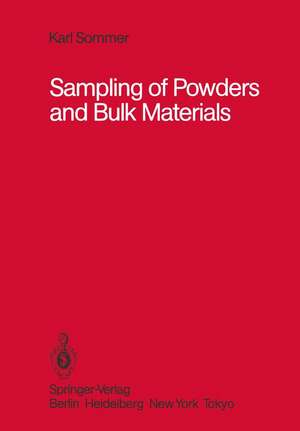Sampling of Powders and Bulk Materials
Autor Karl Sommeren Limba Engleză Paperback – 14 dec 2011
Preț: 642.83 lei
Preț vechi: 756.27 lei
-15% Nou
Puncte Express: 964
Preț estimativ în valută:
123.04€ • 126.80$ • 103.87£
123.04€ • 126.80$ • 103.87£
Carte tipărită la comandă
Livrare economică 01-15 martie
Preluare comenzi: 021 569.72.76
Specificații
ISBN-13: 9783642826078
ISBN-10: 3642826075
Pagini: 304
Ilustrații: X, 292 p. 43 illus.
Dimensiuni: 170 x 244 x 16 mm
Greutate: 0.49 kg
Ediția:Softcover reprint of the original 1st ed. 1986
Editura: Springer Berlin, Heidelberg
Colecția Springer
Locul publicării:Berlin, Heidelberg, Germany
ISBN-10: 3642826075
Pagini: 304
Ilustrații: X, 292 p. 43 illus.
Dimensiuni: 170 x 244 x 16 mm
Greutate: 0.49 kg
Ediția:Softcover reprint of the original 1st ed. 1986
Editura: Springer Berlin, Heidelberg
Colecția Springer
Locul publicării:Berlin, Heidelberg, Germany
Public țintă
ResearchCuprins
1 Introduction.- 2 Fundamentals of Statistics.- 2.1 Frequency distribution of discrete attributes.- 2.2 Cumulative frequency of discrete attributes.- 2.3 Arithmetic mean and sample variance for discrete distributions.- 2.4 Frequency distribution of continuous attributes.- 2.5 Expectation and variance of one-dimensional probability functions.- 2.6 Two-dimensional distribution functions.- 2.7 Expectations and variances of a two-dimensional distribution function.- 2.8 Conditional expectations.- 2.9 Rules for calculating expectations and variances.- 2.9.1 One-dimensional distribution functions.- 2.9.2 Two-dimensional distribution functions.- 2.9.3 Conditional distribution functions.- 3 Random Sampling Distributions.- 3.1 Concept of the random sample.- 3.2 Sampling without replacement.- 3.3 Random sampling with replacement.- 3.3.1 Binomial replacement.- 3.3.2 Poisson distribution.- 3.3.3 Normal distribution.- 4 Sampling from a Population Having an Arbitrary Distribution of the Attribute.- 4.1 Sampling with replacement.- 4.2 Sampling without replacement.- 5 Inference from the Sample About the Population (Confidence Intervals).- 5.1 Sampling when the variance of the population is known.- 5.2 Normally distributed populations with known variance ?2.- 5.3 Sampling from normally distributed populations with unknown variance.- 5.3.1 Chi-square distribution (confidence interval for sample variances.- 5.3.2 The t distribution (confidence intervals for means when the variance is unknown.- 6 Sampling Procedures.- 6.1 Random and systematic sampling.- 6.2 Stratified sample.- 6.3 Proportional subdivision a stratified sample.- 6.4 Cost-optimizing selection for a stratified sample.- 6.5 Example of stratified sampling.- 6.6 Multi-stage sampling.- 6.7 Cost-optimizing selection in multi-stagesampling.- 6.8 Example of multi-stage sampling.- 6.9 Double sampling for bulk material.- 7 Sampling from a Random Mixture.- 7.1 Sampling with a constant number n of particles from a two-material mixture.- 7.1.1 Variance of the numerical concentration.- 7.1.2 Variance of the concentration by mass.- 7.2 Sampling with a constant sample size n from a multi-material mixture.- 7.3 Sampling with a constant mass (or volume) from a two-component mixture.- 7.3.1 The problem of a random mixture formed from two even-grained fractions of any size.- 7.3.2 Random mixture of two even-grained fractions.- 7.4 Constant sample mass and the random mixture of several components of unequal grain size.- 7.5 Random mixture of two particle-size distributions.- 7.6 Random mixture for suspensions.- 8 Sampling in a Sample Divider.- 8.1 Numerical concentration in the case of two or more components.- 8.2 Variance of the concentration by mass of two or more components having differing even-grain fractions.- 8.3 Variance of the concentrations by number and by mass for a two-material mixture.- 8.4 Experiments on a rotary sample-divider from Messrs. Retsch.- 9 Sampling for Grain-Size Analysis.- 9.1 Object and method of sampling.- 9.2 Sampling error for sampling with a constant particle number n from a numerical distribution Q0.- 9.3 Sampling error for sampling with a constant particle number n from a cumulative volume distribution Q3.- 9.4 Sampling error of a cumulative volume distribution Q3 for constant sample masses of solid in the sample.- 9.5 Sampling error of a numerical distribution Q0 or of a cumulative volume distribution Q3 in sampling with a constant suspension volume VSus from a suspension.- 9.6 Sampling error in sample-dividing.- 9.6.1 Cumulative numerical distribution Q0.- 9.6.2 Cumulativevolume distribution Q3.- 10 Sampling Error when Sampling from Ores and Fuels.- 11 Investigations of Random Packings.- 11.1 Definitions and formulation of the problem.- 11.2 Relationship between area porosity and volume porosity.- 11.3 Test for random packing.- 11.4 Grain size analysis by determination of the diameters of sectioned solid particles.- 11.4.1 Determination of all moments Mn,o of the sphere diameter distribution from the moments Mk,o of the section circle diameter distribution.- 11.4.2 Solution of the integral equation.- 11.4.3 Determination of sphere diameter distributions qo (d) with the aid of a histogram of section circle diameters.- 12 Sampling from Non-Random Mixtures.- 12.1 Systematic variance.- 12.2 Correlation length, correlogram.- 13 Sampling from a Convevor Belt.- 13.1 Variance within and between belt sections of lenght L.- 13.2 Inspection of given quantities when sampling randomly or systematically from a conveyor belt.- 14 Sampling Devices.- 14.1 Devices for sampling liquids.- 14.2 Devices for sampling gases and dusts.- 14.3 Devices for sampling granular and lumpy material.- 14.4 Sample splitters.- Notes.- Literature.













